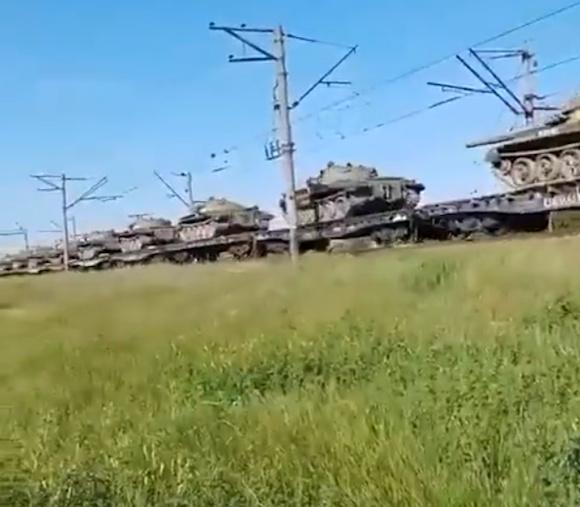Apparently the Army of the Russian Federation is also bringing in the latest versions (dating back to the 80s of the last century) of the T-62, in order to continue fueling the fighting in Ukraine.
When he appeared on Red Square for the May 9 parade, he aroused no little surprise in the eyes of Western analysts. It was immediately clear that the new MBT was armed not with a 100 mm piece (T-54/55) but with something different. In fact, General Aleksandr Aleksandrovič Morozov - the "father" of Soviet tanks - wanted to create a tank with superior armament compared to its predecessors and, to this end, he developed the 2 mm smooth-bore 20A115 cannon, thus a significant change of direction compared to the rifled barrels built until then. We remind you that a piece with a smooth bore requires ammunition equipped with stabilizing fins, however it has lower costs and gives the project a significantly higher initial speed (V₀), with the same charge, compared to a rifled one.
The new MBT had the same small dimensions as the T-54/55 series, only the internal spaces were even more cramped, also considering the greater volume of the 115 mm shots compared to the 100 mm ones. In particular, after having housed the three crew members in the turret (commander, gunner and servant), there was very little space left for the ejected shells. To overcome this serious problem, an innovative automatic cartridge case ejection system was used: after firing, the barrel was automatically positioned at a 3 ° 30 'elevation, making the breech coincide with a rear opening of the dome (not the cartridge case always centered the ejection window. When this happened it bounced inside the fighting chamber). The problem, however, was that the procedure slowed down the rate of fire considerably, as the servant was forced to operate in a very narrow space (this is why, from the following tanks, T-64, it was decided to adopt an automatic loading system, reducing the crew members to three).
The solution described above was not very successful: the launch charges, separated in a double carousel on the bottom of the T-62, were excessively exposed to the shots that entered the combat chamber, causing it to ignite and therefore the deflagration of the tank.
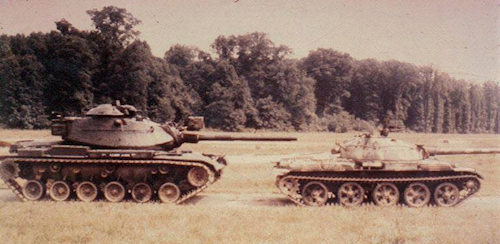 Undoubtedly, on the surface, it was a very interesting MBT, with a much more compact architecture than the contemporary Western tanks, such as the American M-60 (in the photo on the left).
Undoubtedly, on the surface, it was a very interesting MBT, with a much more compact architecture than the contemporary Western tanks, such as the American M-60 (in the photo on the left).
The T-62 has a conventional type of protection, that is made with homogeneous steels and without spacing. However, the inclination of the plates helped to increase the thickness of the armor, especially against the threat of the kinetic penetrators of the 105/51 mm guns of NATO MBTs. In reality, this inclination could not counteract, not only against 105 mm APFSDS sabots, but also against HEAT grenades and western anti-tank missiles. The time of homogeneous armor was coming to an end, in the West they were experimenting with spaced armor and, above all, the even more advanced composite armor.
The front protection of the hull of the T-62 has a protection with a thickness of 100 mm (inclined by 55 °), while the front part of the turret, thanks to the particular inclination, reaches a thickness of 230 mm. However, the part above the engine only reaches 16mm thick, making it highly vulnerable to fire from, for example, the M-163 Vulcan 20 mm installed on most American aircraft of the time.
In short, the T-62 was completely defenseless against NATO anti-tank weapons of the 60s.
Propulsion is ensured by a 55 Hp V-580V diesel engine, with 12 “V” cylinders (the same as the T-55).
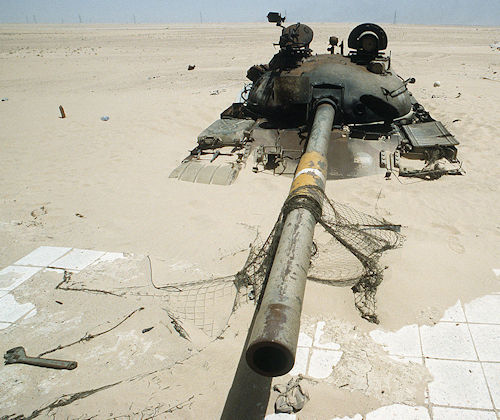
As is known, the engines of the Soviet period were plagued by various problems, especially when the tanks were operating in hot climates (Middle East). Furthermore, the lack of an air conditioning system brings the temperature inside the cabin to very high values (a problem also found in Indian T-90s).
The maximum speed is approximately 50 km / h. the pilot has a very limited view, being able to have only two viewers.
We now come to the main armament of the T-62.
The 2 mm 20A115 smooth-bore gun has a theoretical firing rate of 4/5 rounds per minute. The barrel length is equal to 55 calibers, giving the shot a high initial speed (the APFSDS BD / 36-2 projectile has a V₀ of 1.650 m / sec., With a maximum range of 2.000 meters). Certainly the physical parameters are very respectable for the time but we must consider that the Soviet tungsten shot never offered sufficient performance, due to the low quality of the USSR metallurgical industry (often the penetrator, on impact, tended to break thus reducing the piercing effect).
Piece 2A20, like all Soviet guns, can also fire AT-12 anti-tank missiles Swingers laser, with a maximum range of 5.500 meters.
As for the gun elevation, it varies from + 18 ° to -3 °, this involves many problems when you have to engage targets on different levels. Add in that the pan and tilt is manual, so the ability to quickly acquire moving targets is reduced.
The T-62 is equipped with a cannon coaxial infrared projector (now largely outdated). The commander has a small infrared projector. In later versions, some tanks were fitted with passive night vision goggles for both the pilot and the gunner, while the commander uses portable luminescence-intensifying binoculars.
Obviously, over time, the T-62 has undergone improvements in terms of the firing conduct system.
The first massive use of the T-62 occurred during the invasion of Czechoslovakia in 1968. It was subsequently supplied in large quantities to Egypt, Syria and Iraq.
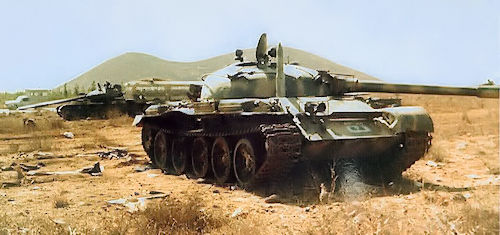 The first use in battle took place during the 1973 Yom Kippur War. Let's say immediately that the behavior of the T-62 in Egyptian and Syrian hands was certainly not exemplary, also because the lack of an adequate ventilation system and the high temperatures, they greatly affected the performance of the Arab crews. Furthermore, the low possibility of pulling in depression, gave the 115 mm piece little functionality in the operating theater of use. The 105 mm shots of the wagons Centurion and M-60, both APFSDS and HEAT, were capable of knocking out the T-62s (photo), even from great distances.
The first use in battle took place during the 1973 Yom Kippur War. Let's say immediately that the behavior of the T-62 in Egyptian and Syrian hands was certainly not exemplary, also because the lack of an adequate ventilation system and the high temperatures, they greatly affected the performance of the Arab crews. Furthermore, the low possibility of pulling in depression, gave the 115 mm piece little functionality in the operating theater of use. The 105 mm shots of the wagons Centurion and M-60, both APFSDS and HEAT, were capable of knocking out the T-62s (photo), even from great distances.
During the war the Israelis captured many T-62s. To adapt them to their needs, the IDFs replaced the 115 mm piece with the 68/105 mm M-51, replaced the original engine with American diesels, installed new aiming systems and new radio equipment.
In 1980 it was the turn of Afghanistan. In this theater, the + 18 ° rise of the T-62 cannon did not allow it to hit targets in high positions. On the other hand, the guerrillas could strike with RPGs in the upper part, not very protected, of the wagons.
In Southern Africa, the Kremlin supplied T-62s to the Angolans of the MPLA, engaged against UNITA and SADF forces. The South African soldiers, to counter them, used busways Ratel armed with a 90 mm piece and, only at the end of the 80s, did they introduce the Olifant (local version of Centurion).
Another intensive use of the T-62 occurred during the Iran-Iraq War (1980-88).
In the course of the conflict, the Russian chariot faced the Chieftain British under the Iranians. Also in this case the T-62 had the worst (even if most of the Iraqi T-62s were destroyed by the TOW wire-guided anti-tank systems).
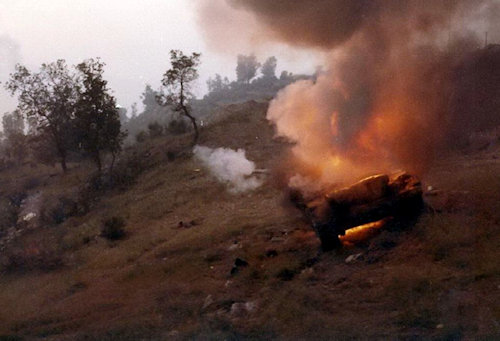 During the 1982 Galilee Peace Operation in Lebanon, the IDF returned to confront the Syrian T-62s, this time they could dispose of the Merkava.
During the 1982 Galilee Peace Operation in Lebanon, the IDF returned to confront the Syrian T-62s, this time they could dispose of the Merkava.
The Israeli Armored Corps knocked out several MBTs sent from Damascus, including a large number of T-62s (photo).
In the wars of 1991 and 2003, other Iraqi T-62s were destroyed by the Americans (many of them by the GAU-8 / A gun Avenger with 7 30x173 mm rotating barrels of the A-10 Thunderbolt II).
At the end of the 62th century, the T-64s were protagonists of the conflicts followed by the dissolution of the USSR, despite the more modern MBTs (such as the T-72B, T-80 and T-XNUMX) were already in service.
The latest versions were equipped with a spaced guard on the sides of the turret and an external laser rangefinder.
In these hours, news reaches us that a convoy of Russian T-62Ms and T-62MVs is headed to Ukraine (opening photo). Apparently, after sixty years, the service of this MBT has not yet ended.
Photo: Twitter / web / ארכיון היסטורי "אגד"

